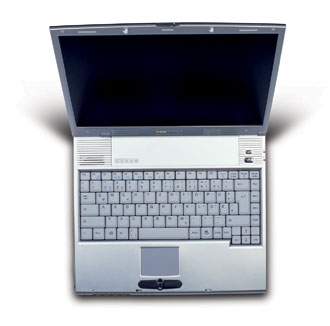

On this page I want to share my experiences with GNU/Linux on my Cebop ATL notebook because it would be nice if the wheel wouldn't have to be reinvented over and over again. The Cebop ATL laptop is a Uniwill N243S1 Barebone equipped by Krystaltech (Lynx Motion 24 6100 seems to be the same product) and is also used by Xeron (Mobile 4 Ultraslim), YAKUMO (Q7M) and other vendors.
Here, I'll give a short summary of the components of the device, which will be described in more detail and with installation descriptions below. To give an overview over my individual configuration, all interesting components are mentioned, sometimes with a driver note. For some of them, there is a link to a detailed description below. Values marked strong refer to my individual configuration.
| Component | Description |
|---|---|
| Processor | Pentium 4-M 1.4 ... 1.8 ... 2.2GHz |
| RAM | 64 ... 512 ... 1024MB |
| BIOS | AMI FLEXBIOS |
| HD | 2.5", 9.5mm, Hitachi 20 ... 30 ... 60GB, UDMA 100, DK23DA-30 |
| Optical Drive | Generic ATAPI drive QSI CD-RW/DVD-ROM SBW-161 |
| Northbridge | SIS 650 (includes graphics) |
| Southbridge | SIS 962 (includes sound, USB, firewire, ethernet, APM, ACPI) |
| Graphics | 14", 1024x768, 8 ... 64 MB shared memory (stolen from RAM), SIS6325 inside SIS650 |
| IDE | SIS5513 inside SIS650 (Kernel 2.4 support) |
| Power Management | APM 1.2, ACPI 1.1 |
| Sound | SIS7012, kernel ALSA support (with snd_intel8x0) |
| USB 1.0 | SIS7001, kernel support |
| Firewire | OHCI-1394, kernel support |
| Ethernet | SIS900, kernel support |
| WLAN | optional, don't have internal (Mini-PCI) one |
| PCMCIA | CardBus bridge: O2 Micro OZ6912 Cardbus bridge, kernel modules support |
| Modem | Smart Link HAMR5600 Winmodem, proprietary kernel modules support |
| Touchpad | Generic PS/2 interface, e.g. in XF86Config4: "/dev/psaux" |
| Hotkeys | WebBrowser, Search, Favorites, Email |
To make it clear: Nearly all of the features of the device are supported under Linux, except (i.e. I haven't found a solution yet):
It's nice to have a combo CDRW/DVD drive. Reading/Writing works, but unfortunately, I didn't manage to blank CDRW discs. This problem was reported several times in the Internet, related to the QSI family of drives.
The integrated graphics chip is supported by the XFree86 driver "sis". I packaged the interactive sisctrl tool for mode and port switching. See #255713.
But I found something better: You can use the kernel options for Software Suspend (swsusp or, alternatively, pmdisk) which writes the contents of RAM to the swap partition and restores the state on next reboot. Unfortunately, both are disabled by default so you need to configure and compile your own kernel. Depending on the driver you are using, you can issue
echo 4 > /proc/acpi/sleepor
echo disk > /sys/power/stateSee also Documentation/power/swsusp.txt in the kernel source tree.
To save energy (and increase battery uptime), Linux can be put to a special mode that normally doesn't use the hard disk and switches it off most of the time. It is spun up only on rare occasions (and if you need to read new data that isn't already in the cache).
To enable Laptop Mode, run:
# laptop_mode start # hdparm -S4 -B1 /dev/hdawhere laptop_mode is a script that can be found in Documentation/laptop-mode.txt in the kernel tree, which you should read anyway.
Note that Laptop Mode had (and probably still has got) some problems with Software Suspend. Don't be surprised if the two interfere with each other.
The integrated Smart Link HAMR5600 is a Winmodem and therefore not intended to be used with free software because of patent issues and due to the fact that Winmodems generally implement Modem functionality in software which is a bad idea. There exist proprietary drivers in the Debian non-free section: sl-modem-daemon (for user space interaction) and sl-modem-source (to be compiled into a kernel module), if you need this functionality.
The Hotkeys in front of the lid generate special keycodes. I wrote a definition file for the Debian package hotkeys. Until it is integrated officially, you can download it from #269753 to /etc/share/hotkeys/uniwilln243s1.def.
To activate it, run:
$ hotkeys -t uniwilln243s1